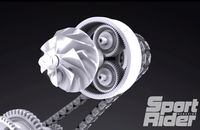In the latest teaser video from Kawasaki for its 2015 Ninja H2R/H2 supercharged sportbikes, the question of how to deal with the main disadvantage of the type of compressor used in its supercharger system is answered.
The Ninja H2R/H2 uses a centrifugal supercharger, which is similar to a turbocharger in design, except that instead of being driven by exhaust gases, the centrifugal supercharger is driven directly off of the engine's crankshaft. The centrifugal supercharger has numerous advantages over the more common "positive-displacement" screw- or Roots-type compressors seen on the majority of OEM automobile applications today, including being much more efficient at generating pressure and creating less heat in the intake charge (also known as adiabatic efficiency), as well as being better suited to high-rpm engine applications because of its ability to continue increasing boost. While the Roots compressor can continue increasing boost as rpm rises, its efficiency is less than optimal, imparting a lot of heat into the intake charge; the screw-type compressor generates less heat, but it has a difficult time increasing boost as rpm rises.
The biggest disadvantage with the centrifugal supercharger is that it needs to spin fast in order to produce any low-end torque (unlike the positive displacement compressors that can produce boost almost instantly), and also that its boost increases exponentially in relation to rpm. This means if you utilize a gear ratio to spin the centrifugal compressor faster at lower rpm to produce good low-end torque, it will produce too much boost at higher rpm as well as operate beyond its optimum efficiency envelope.
Kawasaki solved this problem by using a step-up gear system in addition to a planetary gearset to drive the supercharger's impeller shaft. The step-up gear set is driven directly by the H2's crankshaft and spins slightly higher than engine speed. A chain drive takes power from there to a planetary gear set that resides inside the supercharger's housing. As shown in the video, the combined effect is to turn an engine speed of approximately 14,000 rpm into an impeller speed of 130,000 rpm. A planetary gear set is one way to provide a significant change in gearing within a small space. On the H2R, the engine turns the outer gear, which is traditionally called the ring gear, and motion is transferred to the three planet gears and on to the central sun gear to which the impeller is directly mounted.
According to patent documents filed by Kawasaki in 2010, an additional method to keep the supercharger spinning fast enough to generate boost at low engine rpm is to use a two-speed gearbox in the step-up gear system. The patent describes the step-up system as having two gear sets; at low rpm one set is in use, while at higher rpm the second set is automatically engaged and the supercharger speed is reduced. The animation in the video indicates this method is used on the H2R, as two gears can be seen on the step-up shaft just above and behind the crankshaft.

/cloudfront-us-east-1.images.arcpublishing.com/octane/6CP6VKBMDRHPNLH4JFYVW6DMCM.jpg)
/cloudfront-us-east-1.images.arcpublishing.com/octane/4FYW5AN7YVFZBMWPAZ6COUXJJ4.jpg)
/cloudfront-us-east-1.images.arcpublishing.com/octane/VUOTFUMRZBFILJ4TBSKYNRPZDM.jpg)
/cloudfront-us-east-1.images.arcpublishing.com/octane/A2TMJNBKPBEQJEF6PB2Q5PGQHM.jpg)
/cloudfront-us-east-1.images.arcpublishing.com/octane/4YLIEQ7HGBH4FNXXYONJYS5K7U.jpg)
/cloudfront-us-east-1.images.arcpublishing.com/octane/5BDFMBN2KJE7JNJK7LJ7EG4A2M.jpg)
/cloudfront-us-east-1.images.arcpublishing.com/octane/C3WGBZCFABC7XKBCFCCXDWYWME.jpg)
/cloudfront-us-east-1.images.arcpublishing.com/octane/PLQ5M7MG3RG7BHYH2OILWJZIPY.jpg)
/cloudfront-us-east-1.images.arcpublishing.com/octane/CCPZFYVVRBF2DLPMDYKPF4TMME.jpg)
/cloudfront-us-east-1.images.arcpublishing.com/octane/SIAXQ2ZOPNBYBLPKJPCHIYGG6A.jpg)
/cloudfront-us-east-1.images.arcpublishing.com/octane/LRRTQXMMAFBVFOUYC2RI6ZBEAY.jpg)
/cloudfront-us-east-1.images.arcpublishing.com/octane/2NE3IENERFBTPDKVXPNTSMZZXE.jpg)
/cloudfront-us-east-1.images.arcpublishing.com/octane/7EG6FR6QOJGR7FFROLIPDUVTVM.jpg)
/cloudfront-us-east-1.images.arcpublishing.com/octane/QC73NNGYHZDWTNVTLNABEDJJ2Y.jpg)
/cloudfront-us-east-1.images.arcpublishing.com/octane/LMMTOYLL7BGE3FLR3OXDA4YQUI.jpg)
/cloudfront-us-east-1.images.arcpublishing.com/octane/EGXXXTWM2NABTOFTZBMZ2MWLUQ.jpg)
/cloudfront-us-east-1.images.arcpublishing.com/octane/EKKSANJIXNHQTNCANRHSTW7JHE.jpg)
/cloudfront-us-east-1.images.arcpublishing.com/octane/QSA4M5BQLFBAHIX33LEC63FH6M.jpg)
/cloudfront-us-east-1.images.arcpublishing.com/octane/OK3LWSOK3ZCMHJZZCEHOL2SRKQ.jpg)
/cloudfront-us-east-1.images.arcpublishing.com/octane/4E4BRX2RXVGNPCK4ODPMSUVBC4.jpg)
/cloudfront-us-east-1.images.arcpublishing.com/octane/SSLY6CGFJNDLVKSP5LBWZKVIHU.jpg)
/cloudfront-us-east-1.images.arcpublishing.com/octane/ENCTP2GIJ5DFVH2QPFJRFJ3IDI.jpg)
/cloudfront-us-east-1.images.arcpublishing.com/octane/P67HV34OANAFBDVK6U4FQ2M3YM.jpg)
/cloudfront-us-east-1.images.arcpublishing.com/octane/TG75U5MBR5FI3INUFFJEFMCOZI.jpg)